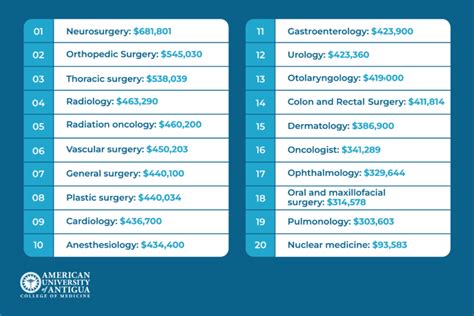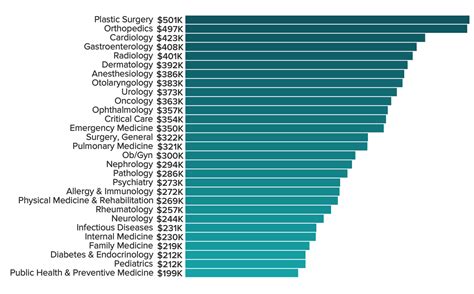A career in medicine is one of the most respected and demanding paths one can pursue. It offers the profound reward of improving and saving lives, coupled with significant intellectual challenges. It also represents one of the most lucrative career fields in the world. While nearly all physicians earn a substantial income, the financial landscape varies dramatically from one specialization to another. For prospective medical students and residents, understanding these differences is a crucial part of career planning.
On average, physicians and surgeons in the United States earn a median salary of $239,200 per year, according to the U.S. Bureau of Labor Statistics. However, this figure is just a starting point. Depending on the chosen specialty, annual compensation can range from around $200,000 to well over $700,000. This guide will break down the highest-paying medical specialties and explore the key factors that influence a physician's earning potential.
Understanding the Role of a Medical Specialist

After completing four years of medical school to earn an M.D. or D.O. degree, a doctor's journey is far from over. They must then enter a residency program, which provides 3-7+ years of supervised, hands-on training in a specific area of medicine. This is where a doctor becomes a specialist.
A medical specialist is a physician who has expert knowledge and skills in a particular field, such as cardiology (the heart), oncology (cancer), or orthopedics (bones and joints). Their responsibilities include:
- Diagnosing complex and often rare conditions within their field.
- Developing and managing long-term treatment plans for patients with chronic illnesses.
- Performing highly technical procedures, from minimally invasive surgeries to complex operations.
- Consulting with primary care physicians and other specialists to provide optimal patient care.
- Staying current with cutting-edge research, technology, and treatments.
The nature of this work—whether it is primarily cognitive (like internal medicine) or procedural (like surgery)—is a major determinant of compensation.
Highest-Paying Medical Specialties: A Comparative Look

Data from leading industry reports consistently show a clear hierarchy in physician salaries, with surgical and procedural-based specialties topping the list. Below is a look at the average annual compensation for top medical specialties.
According to the Medscape Physician Compensation Report 2023, which surveyed over 10,000 physicians across more than 29 specialties, these are the highest earners:
1. Plastic Surgery: $619,000
2. Orthopedics: $573,000
3. Cardiology: $507,000
4. Urology: $506,000
5. Gastroenterology: $501,000
6. Otolaryngology (ENT): $485,000
7. Radiology: $483,000
8. Oncology: $463,000
9. Anesthesiology: $448,000
10. Dermatology: $443,000
For perspective, specialties focused on primary care tend to be at the lower end of the physician pay scale, though they still represent very high incomes:
- Internal Medicine: $273,000
- Family Medicine: $255,000
- Pediatrics: $251,000
The Doximity 2023 Physician Compensation Report shows similar trends, with neurosurgery, thoracic surgery, and orthopedic surgery leading their list with average compensations exceeding $600,000.
Key Factors That Influence Salary

While specialty is the single biggest factor, several other variables significantly impact a physician's earnings.
### Level of Education and Training
All physicians complete a bachelor's degree and medical school. However, the length and competitiveness of their postgraduate training (residency and fellowships) directly correlate with salary. Surgical specialties like neurosurgery or orthopedics require residencies that can last five to seven years, often followed by a one-to-two-year fellowship for further sub-specialization. This extensive, highly demanding training commands higher compensation in the job market compared to a three-year primary care residency.
### Years of Experience
Like any profession, experience matters. A physician's salary grows throughout their career.
- Resident/Fellow: Earn a modest salary (typically $60,000-$80,000) while in training.
- Early-Career Attending: Sees a massive salary jump upon completing residency and becoming a fully licensed physician.
- Mid-to-Late Career: Compensation continues to rise with experience, reputation, and potentially, partnership in a private practice. A senior partner in a surgical group will almost certainly earn more than a new hire.
### Geographic Location
Where a physician practices has a major impact on their paycheck. However, it's not as simple as higher cost-of-living areas equating to higher pay. Often, the opposite is true. According to Doximity's 2023 report, metropolitan areas with the highest physician compensation included cities like Charlotte, NC, and St. Louis, MO.
The principle of supply and demand governs physician salaries by location. Large, desirable cities like New York and Los Angeles have an abundance of specialists, which can suppress salaries. Conversely, rural areas and less populated states often offer higher compensation and significant signing bonuses to attract and retain much-needed medical talent.
### Practice Setting
The type of organization a physician works for is a critical factor in their earning potential.
- Self-Employed/Private Practice: This setting offers the highest earning potential. Physician-owners not only earn a clinical salary but also share in the profits of the business. However, this comes with the responsibilities and risks of running a business, including managing overhead, billing, and staff. Medscape reports that self-employed physicians earn significantly more on average than their employed counterparts ($402,000 vs. $344,000).
- Hospital-Employed: Working directly for a hospital or large healthcare system provides a stable, predictable salary, excellent benefits, and freedom from administrative burdens. This is an increasingly common and popular model.
- Academic Medical Centers: Physicians at universities often earn less than those in private practice. Their compensation is balanced by the non-monetary rewards of teaching the next generation of doctors, conducting research, and handling clinically complex and rare cases.
- Government: Working for institutions like the Department of Veterans Affairs (VA) or the military typically offers lower salaries but comes with strong job security and excellent federal benefits.
### Area of Specialization
As detailed in the list above, this is the most significant factor. The "why" behind the salary disparity is multifaceted:
- Procedural vs. Cognitive Work: Specialties that perform procedures (surgeries, invasive imaging, scoping) are reimbursed at much higher rates by insurance companies than specialties that are primarily focused on diagnosis and management (like endocrinology or family medicine).
- Urgency and Acuity: Fields that deal with life-and-death situations and complex, acute conditions (e.g., cardiology, neurosurgery) command higher pay.
- Technology and Equipment: Specialties that rely on expensive, high-tech equipment (like radiology and radiation oncology) have a high-cost structure that translates to higher revenue and salaries.
Job Outlook

The career outlook for physicians and surgeons is excellent. The U.S. Bureau of Labor Statistics (BLS) projects a 3% growth in employment for this field from 2022 to 2032. While this is about as fast as the average for all occupations, the demand for physicians remains incredibly strong and will continue to grow. An aging U.S. population requires more medical care, particularly from specialists who manage chronic conditions common in older adults, such as heart disease and cancer. This sustained demand ensures robust job security and maintains high salary potential for physicians across all specialties.
Conclusion

Choosing a medical specialty is one of the most important decisions a future doctor will make. While financial compensation should not be the only consideration, it is an essential piece of the puzzle.
Key Takeaways:
- Physician salaries are among the highest of any profession but vary dramatically, from around $250,000 to over $600,000 annually.
- The single greatest factor influencing salary is the area of specialization, with surgical and procedural-based fields like plastic surgery, orthopedics, and cardiology leading the way.
- Other critical factors include your years of experience, the geographic location of your practice (with rural areas often paying more), and your practice setting (private practice generally offers the highest potential).
- The extensive length and rigor of your training in residency and fellowships directly correlate with your future earning power.
For those embarking on the long road to becoming a physician, the path is challenging but the rewards—both personal and financial—are immense. Balancing a passion for a particular field of medicine with a clear understanding of the financial landscape will empower you to build a career that is both fulfilling and prosperous.
